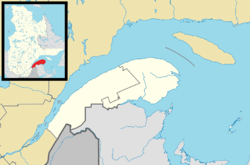
Mirabel is a suburb of Montreal, located on the North Shore in southern Quebec.
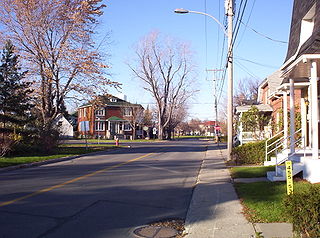
Vaudreuil-Dorion is a suburb of Greater Montreal, in the Montérégie region of southwestern Quebec, Canada. The result of the merger of two towns, Vaudreuil and Dorion, it is located in the Vaudreuil-Soulanges Regional County Municipality.

Les Basques(the Basques) is a regional county municipality in the Bas-Saint-Laurent region in eastern Quebec, Canada. It is located on the south bank of the Saint Lawrence River halfway between Rimouski and Rivière-du-Loup.

La Matanie is a regional county municipality, located in the Bas-Saint-Laurent region of Quebec, in Canada. From January 1, 1982, to March 9, 2013, it was known as Matane.

L'Assomption is an off-island suburb of Montreal, in southwestern Quebec, Canada on the L'Assomption River. It is the seat of the Regional County Municipality of L'Assomption. It is located on the outer fringes of the Montreal urban area.

Dolbeau-Mistassini is a town in northern Quebec, Canada, at the confluence of the Mistassibi River, Riviere aux Rats and the Mistassini River, on Lac Saint-Jean. Dolbeau-Mistassini is in the Maria-Chapdelaine Regional County Municipality and is the commercial hub of Lac-St-Jean with big stores and shopping centres.

Chandler is a town in the Gaspésie–Îles-de-la-Madeleine region of Quebec, Canada. It is the second-most populous town on the Gaspé Peninsula after the Town of Gaspé. It was known as Pabos between June 27, 2001 and May 4, 2002.

Delson is an off-island suburb of Montreal, Quebec, Canada. It is situated 8 mi/13 km SSE of Montreal within the regional county municipality of Roussillon in the administrative region of Montérégie. The population as of the Canada 2021 Census was 8,328.
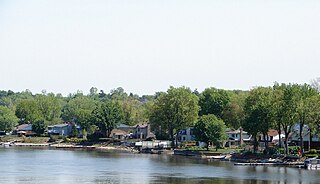
The Town of Île-Perrot is a town and municipality on Île Perrot in southwestern Quebec, Canada. The population as of the Canada 2016 Census was 10,756. The town is at the western end of Lake Saint-Louis, and borders the local island communities of Terrasse-Vaudreuil, Pincourt and Notre-Dame-de-l'Île-Perrot. It also includes Dowker Island and the small Claude and Bellevue Islands.
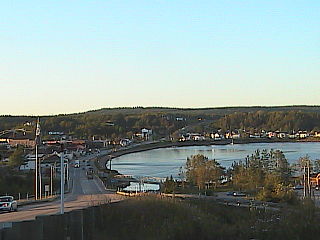
Les Escoumins is a municipality in La Haute-Côte-Nord Regional County Municipality in the Côte-Nord region of Quebec. It is located on the north shore of the maritime estuary of the St. Lawrence River.

Carignan is a suburban municipality in southwestern Quebec, Canada, on the Richelieu River in La Vallée-du-Richelieu Regional County Municipality, about 27 km (17 mi) from Montreal. The population as of the Canada 2021 Census was 11,740.
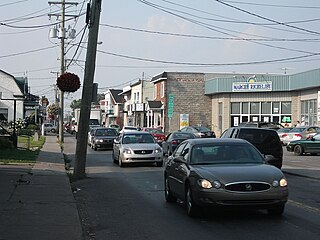
Saint-Lin–Laurentides is a small city located in the Montcalm Regional County Municipality of Quebec, Canada. Its official name uses an en dash; however, the city's own website uses the two-hyphen version of its name: Saint-Lin-Laurentides. In the Canada 2021 Census its population was 24,030.

Paspébiac is a city on Baie des Chaleurs in the Gaspésie region of eastern Quebec, Canada. The population was 3,033 as of the Canada 2021 Census. The town is noted for the Banc de Pêche de Paspébiac, a large sandbar jutting out into the bay which has been designated a National Historic Site of Canada.

Coteau-du-Lac is a small city in southwestern Quebec, Canada. It is on the north shore of the St. Lawrence River in the Vaudreuil-Soulanges Regional County Municipality.

Contrecœur is a city in southwestern Quebec, Canada on the south shore of the St. Lawrence River. The population as of the Canada 2021 Census was 9,480. Contrecœur is approximately 45 kilometres (28 mi) northeast of Montreal and is accessible via Autoroute 30, the main road from the southwest, which continues on to Sorel-Tracy.

Notre-Dame-de-l'Île-Perrot is the largest of four municipalities located on Île Perrot, west of the island of Montreal, Quebec. The population as of the Canada 2016 Census was 10,654. It hosts the island's first church built in 1740 originally situated at Pointe-du-Moulin which was reconstituted as the Chapelle du Souvenir in 1953 beside the church of Sainte-Jeanne-de-Chantal across from the town hall.

Causapscal is a city in the Canadian province of Quebec, located in La Matapédia Regional County Municipality. It is located at the confluence of the Matapédia and Causapscal Rivers, along Quebec Route 132, approximately halfway between Mont-Joli and Campbellton, New Brunswick. It is served by the Causapscal railway station and the Causapscal Airport.

Barkmere is a ville in the Canadian province of Quebec, located in Les Laurentides Regional County Municipality.

Portneuf is a municipality in the Portneuf Regional County Municipality, in the province of Quebec, Canada. It is located on the Saint Lawrence River, between Quebec City and Trois-Rivières. The Portneuf River runs on the east side of the town centre.
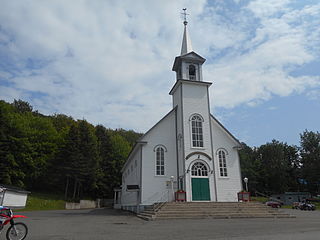
Notre-Dame-des-Neiges is a municipality in Quebec, Canada. It encircles the city of Trois-Pistoles and includes the offshore Île aux Basques.




